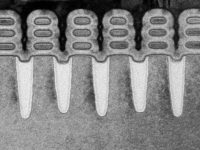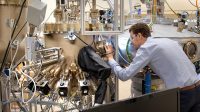The Nanosheet Transistor Is the Next (and Maybe Last) Step in Moore’s Law

The modern microprocessor is among the world’s most complex systems, but at its heart is a very simple, and we think beautiful, device: the transistor. There are billions of them in a microprocessor today, and they are nearly all identical. So improving the performance and boosting the density of these transistors is the most straightforward way to make microprocessors—and the computers they power—work better.
Boeing, Applied Materials and Others Join New Corporate Partnership Program

The Chicago Quantum Exchange, a growing intellectual hub for the research and development of quantum technology, has expanded its community to include new industry partners working at the forefront of quantum technology and research. These corporate partners are Boeing, Applied Materials, Inc., ColdQuanta, Inc., HRL Laboratories LLC and Quantum Opus LLC.
HRL Podcast E05 | Mike Daily and Dave Payton

Current HRL scientists Mike Daily and Dave Payton are pioneers in modern robotics, artificial intelligence, machine learning, and autonomy to name just a few of their areas of expertise.
Can a Prosthetic Hand Feel Real Without Maintenance?

Heiko Hoffmann explains the HRL patent Device and method to automatically tune the nerve stimulation pattern of a sensory-feedback capable prosthesis.
HRL’s Sparse Associative Memory Emulates a Major Function of the Brain

HRL has developed a computer model of human associative memory that surpasses previous models in accuracy while avoiding the common problem of false memories that plagued earlier such models.
SAVER Project to Build on Earlier Cold-Atom Success for Ultra-Precise Position, Navigation, and Timing

HRL Laboratories has been awarded the Swift Alkali Vapor Emitter & Regulator (SAVER) Project to build a key component for future cold-atom clocks and other future systems of ultra-precise position, navigation, and timing (PNT). SAVER will build upon HRL’s previous success building a source of atoms for cold-atom–based devices such as in portable atomic clocks.
Can a Phone Battery Last a Week on One Charge?

Jocelyn Hicks-Garner explains the HRL patent Methods of Making Cathodes for Aluminum Batteries that could lead to much longer lasting batteries.
Can A Vehicle be Ice-proof and Bug-proof?

High-durability Anti-fouling and Anti-icing Coatings: Scientist Andy Nowak explains HRL Laboratories’ patented durable coatings that prevent ice or insects from sticking to airplanes, cars, and other exposed structures.
HRL Laboratories is First Ever to Register New 3D-Printed Alloy

HRL Laboratories is commercializing its additively manufactured (3D-printed) high-strength aluminum, which has obtained the first ever registration of an additive alloy from the Aluminum Association. HRL will be granted registration number 7A77.50 for the aluminum powder used to additively manufacture the alloy, and number 7A77.60L for the printed alloy.
Patent Highlight: System and Method To Detect Attacks On Mobile Wireless Networks Based On Controllability Analysis

Ad hoc mobile networks are extremely useful for soldiers or vehicles that can communicate with each other. However, deployment of these types of communication networks has been limited by security issues. HRL Laboratories’ Gavin Holland explains the patented software system he coinvented to detect misinformation attacks on ad hoc networks.